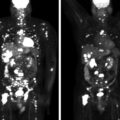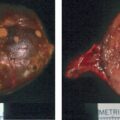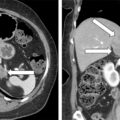The most common type of congenital adrenal hyperplasia (CAH) is 21-hydroxylase deficiency, which occurs in 1 in 10,000 live births. The goals of therapy in CAH include (1) replacement therapy for glucocorticoid and mineralocorticoid deficiency and (2) controlling androgen excess. Here we present a case of classic salt-losing CAH to illustrate the basic principles of CAH management.
Case Report
The patient was a 24-year-old man with history of 21-hydroxylase deficiency who was referred to establish follow-up in the adult endocrine clinic.
PREVIOUS HISTORY
He was diagnosed with 21-hydroxylase deficiency at 10 days of age. At that time, he was hospitalized due to vomiting and weight loss. On admission, he was noted to be hyponatremic (serum sodium concentration, 121 mEq/L) and hyperkalemic (serum potassium concentration, 7.1 mEq/L). Adrenal crisis from primary adrenal insufficiency caused by 21-hydroxylase deficiency was suspected and confirmed with significantly elevated serum 17-hydroxyprogesterone concentrations. Glucocorticoid and mineralocorticoid replacement therapy was initiated (exact doses unknown). He had good follow-up for CAH during childhood. His height was maintained at the 25th–50th percentiles. Initially he was treated with hydrocortisone three times a day, later on with prednisone, and then with dexamethasone to ensure a better control. In addition, he was taking fludrocortisone 150 mcg per day.
CURRENT EVALUATION
The patient reported fatigue and muscle weakness, weight gain, and striae over his abdomen and hip area. He noticed occasional edema in lower extremities. Medications included dexamethasone 0.75 mg at night and fludrocortisone 150 mcg daily. Compliance was excellent. On physical examination, his body mass index was 32.38 kg/m 2 , blood pressure 145/102 mmHg, and heart rate 79 beats per minute. He had abdominal obesity, mild dorsocervical pad, mild supraclavicular pads, and bright purple striae over his abdomen and hips. His skin was not thin, and there were no visible bruises. He had mild bilateral lower extremity edema.
INVESTIGATIONS
Laboratory test results are shown in Table 87.1 . The serum androstenedione concentration was low and the serum concentration of 17-hydroxyprogesterone was normal. Bone mineral density revealed low bone mass with a T score of −2.8 at the level of spine and T score of −1.7 at the level of hips. Ultrasound of testes was performed to evaluate for presence of testicular adrenal rest tumors (TARTs) and was normal. Biochemical workup demonstrated a normal fasting glucose but abnormal lipid profile (total cholesterol of 220 mg/dL, normal range, <200).
| Biochemical Test | Baseline | Follow-up | Reference Range |
| Dexamethasone 0.75 mg Daily Fludrocortisone 150 mcg Daily | Hydrocortisone 30 mg Daily Fludrocortisone 100 mcg Daily | ||
| 17-Hydroxyprogesterone, ng/dL DHEA-S, mcg/dL Androstenedione, ng/dL Total testosterone, ng/dL Bioavailable testosterone, ng/dL Plasma renin activity, ng/mL per hour | 205 — 29 — — 0.8 | 2390 76 116 288 127 2.7 | <220 89–457 40–150 240–950 50–190 <0.6–3.0 |
Stay updated, free articles. Join our Telegram channel

Full access? Get Clinical Tree








